Quality of Fixed Networks in Costa Rica 2023: Coverage, Speed, and User Experience (I)
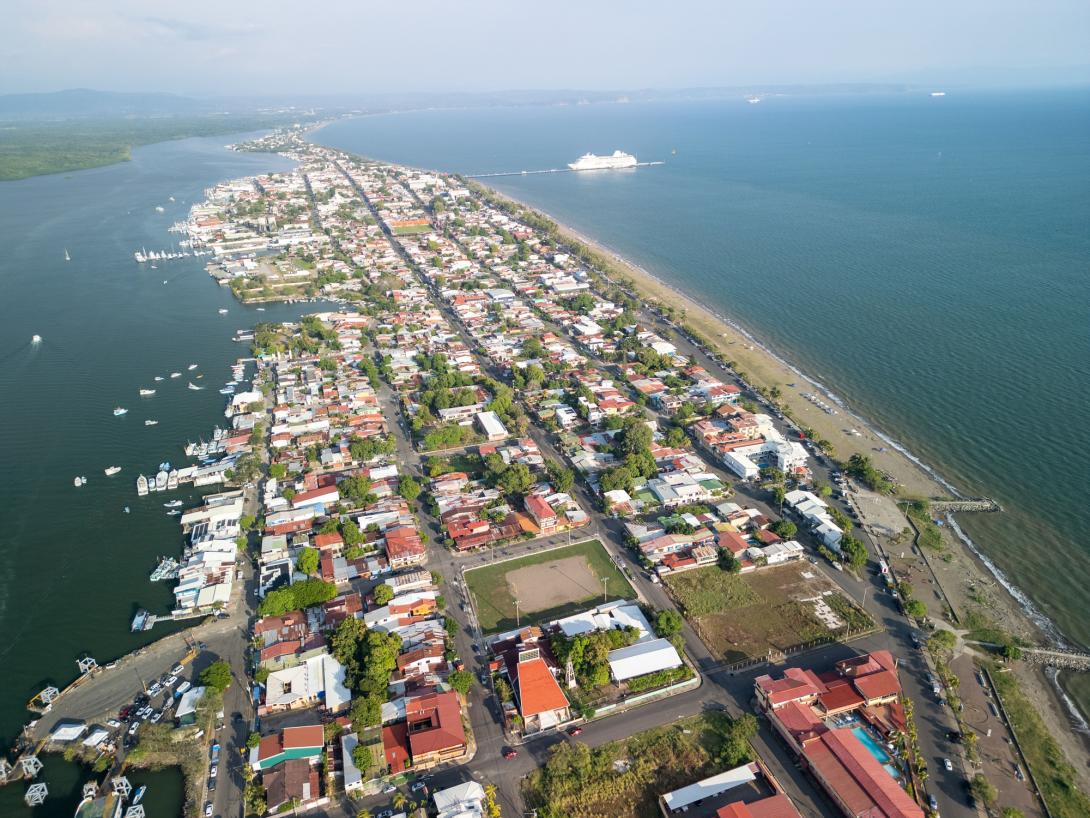
This article is part of a monographic series analyzing the quality of telecommunications networks in Costa Rica. This time, we explore the performance of fixed Internet networks, which are crucial for the country's digital development and the daily lives of Costa Ricans. Through this analysis, we highlight the progress, challenges, and areas for improvement that affect user experience. For additional insights, don’t miss the next article in the series, which discusses the quality of mobile networks under the title “Connected Costa Rica: What Is the Quality of Mobile Networks in the Country? (II)”.
In the latest report by SUTEL, based on the most recent data from 2023, a detailed analysis of the quality of fixed network services in Costa Rica is presented. This report evaluates the performance of the country’s main operators, including:
- Instituto Costarricense de Electricidad (Kölbi)
- Liberty S.A. (including Cabletica and Telefónica Movistar)
- Telecable S.A.
- Millicom Cable de Costa Rica S.A. (Tigo)
This 2023 report is also a success case for our regulatory solutions, such as SUTEL. Our technology, designed to measure and improve Quality of Service (QoS) and Quality of Experience (QoE) for users, has been a key component in conducting these performance evaluations. MedUX provides real-time measurement tools that allow regulators to obtain accurate data on the conditions of services offered, ensuring that results reflect the true user experience across various environments and situations.
Evaluation Methodology
The new SUTEL report relies on an exhaustive evaluation of mobile service in Costa Rica, using a robust measurement methodology validated by the International Telecommunication Union (ITU), which establishes the use of unattended tests to provide near real-time results. This system, implemented by SUTEL through an operational lease, enables continuous monitoring of the Internet service provided by operators, facilitating the detection of quality degradation and providing a clear view of trends and the evolution of telecommunications services in the country.
The evaluation covered a total of 255 Internet services distributed across the country’s seven provinces. These services were monitored simultaneously and continuously, 24 hours a day, using a measurement system called MedUX Home, which collects data in real time. MedUX Home, consisting of specialized hardware and software, records key performance metrics, such as latency and download and upload speeds, through automated tests like ping and HTTP tests. This distributed system of probes and servers can collect, store, and process large amounts of data to produce detailed statistical analyses of service performance.
Main findings on the quality of fixed Internet access service in Costa Rica during 2024 by SUTEL - National Evaluation of Fixed Internet Service during 2024
The report presents a detailed evaluation of the status and performance of fixed networks in Costa Rican households, based on key indicators that allow determining the quality of Internet service from the user's point of view; among these, the percentage of compliance with the connection speed contracted by users, as well as the network response time or latency, stand out.
Download Speed Performance
In 2023, the performance of download speeds shows that all evaluated operators achieved outstanding levels, surpassing 80% of the provisioned speed according to the national average. Telecable and Tigo stood out this year by achieving 100% compliance with the contracted speed, consolidating their leadership in this metric.
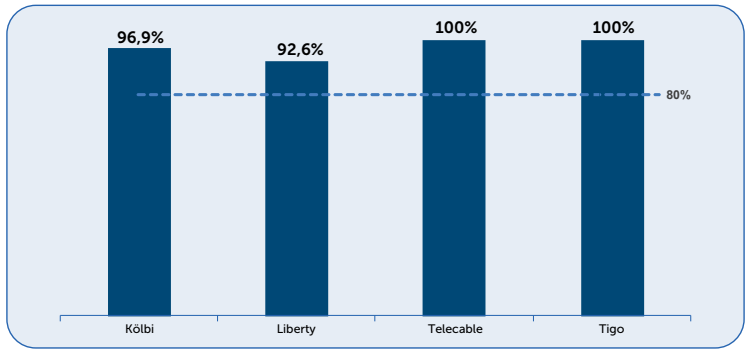
(cifras en milisegundos). Source: SUTEL, Quality Department, Costa Rica, 2023
Compared to the resultados de 2022, operators have shown notable improvements in download speed performance during 2023. Telecable and Tigo, which achieved 89.1% and 92.2%, respectively, in 2022, reached 100% of the contracted speed in 2023, demonstrating significant progress in service delivery. Liberty, although experiencing a slight decline, maintains competitive performance at 92.6%, while Kölbi continues its improvement trend, rising from 88.2% in 2022 to 96.9% in 2023. This progress reflects the efforts of each operator to optimize the quality and consistency of their fixed Internet services in the country.
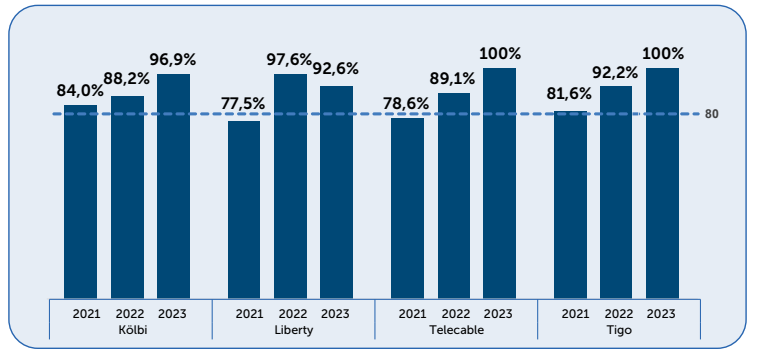
(cifras en milisegundos). Source: SUTEL, Quality Department, Costa Rica, 2023
To analyze the stability of download speeds throughout the day, hourly breakdowns of results for each operator in 2023 are presented. This hourly measurement reveals performance patterns at different times of the day and highlights periods of higher and lower stability in each service. A generalized stability is evident, except for Telecable, which experiences a decrease in this indicator between 6:00 PM and 10:00 PM, though it consistently remains above the regulatory threshold of 80%. This marks an improvement compared to the 2022 study, where both Kölbi and Telecable showed significant drops during peak hours, even falling below the regulatory threshold of 80%.
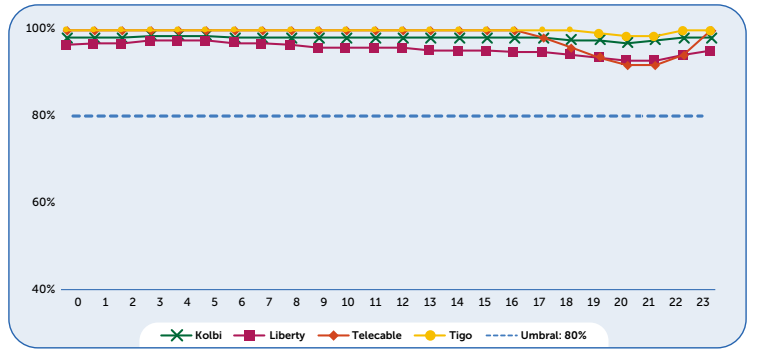
durante el año 2023 (cifras en milisegundos). Source: SUTEL, Quality Department, Costa Rica, 2023
Upload Speed Performance
The upload speed indicator measures Internet service performance by assessing users’ data upload capacity relative to the contracted speed. For the 2023 period, results are compared with the regulatory compliance threshold of 80% and presented as percentage values indicating the degree of performance for each operator nationwide.
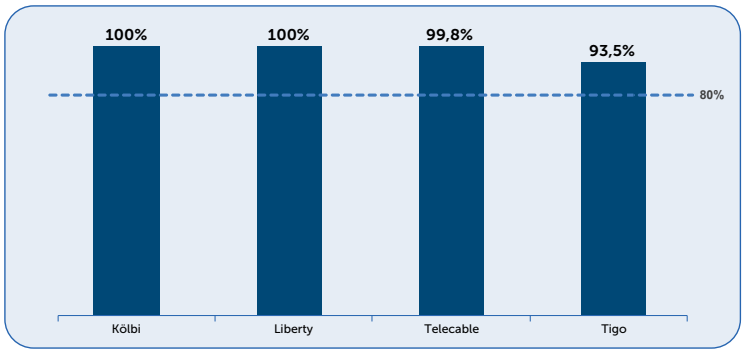
(cifras en milisegundos). Source: SUTEL, Quality Department, Costa Rica, 2023
These results show considerable improvement compared to previous years across all cases. Tigo, for example, appears to be regaining the performance levels it achieved in 2021.
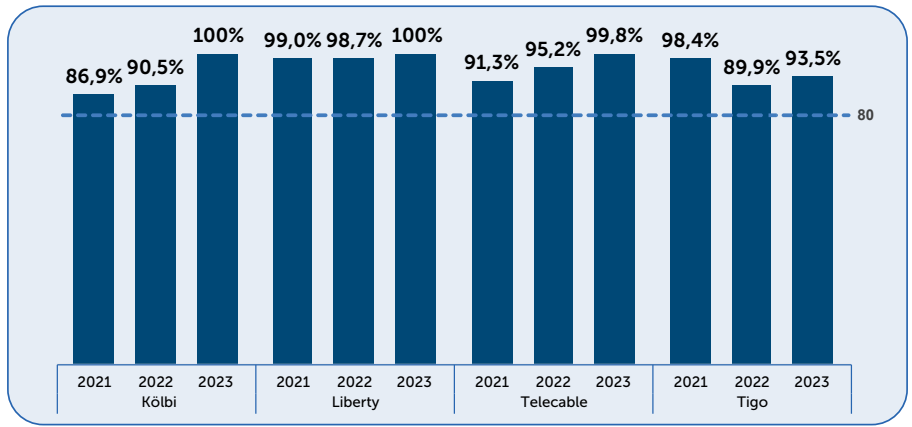
para el operador del 2021 al 2023. Source: SUTEL, Quality Department, Costa Rica, 2023
Local Latency
The local latency indicator evaluates the network’s response time within each operator’s infrastructure, measuring how quickly information packets are transmitted. Lower numerical values indicate better performance, resulting in a smoother user experience.
The following chart presents the average local latency results by operator for 2023. All operators—Kölbi, Liberty, Telecable, and Tigo—comply with the regulatory threshold of 50 ms.
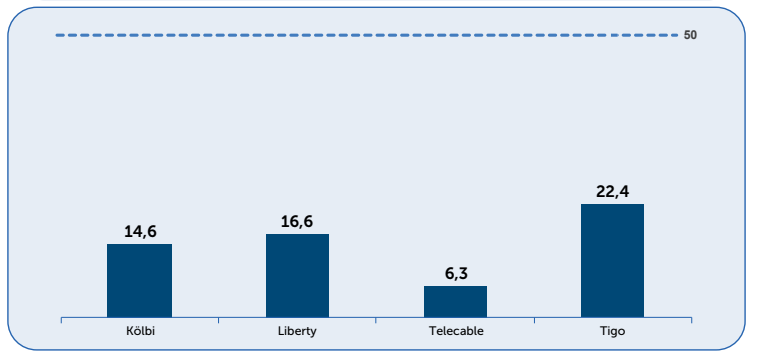
It is noteworthy that Telecable achieved a significant milestone this year by reporting a single-digit local latency value, marking the first time an operator has achieved this level of performance.
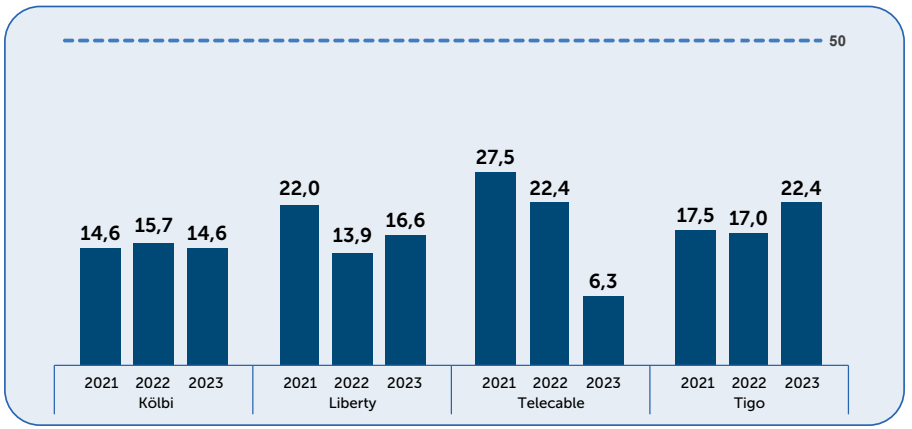
Compared to previous years, improvements are evident for Kölbi and more significantly for Telecable. However, Liberty and Tigo have shown a decline in quality, as their response times have increased compared to previous years. Nevertheless, none of the operators exceed the established threshold.
Average International Latency (Country)
The international latency indicator measures network response times for transmitting information packets across global infrastructure. Lower numerical values indicate better performance experienced by users. Unlike local latency, this indicator does not have a mandatory compliance threshold for operators; however, an informative recommended threshold of 150 ms is established under current regulations.
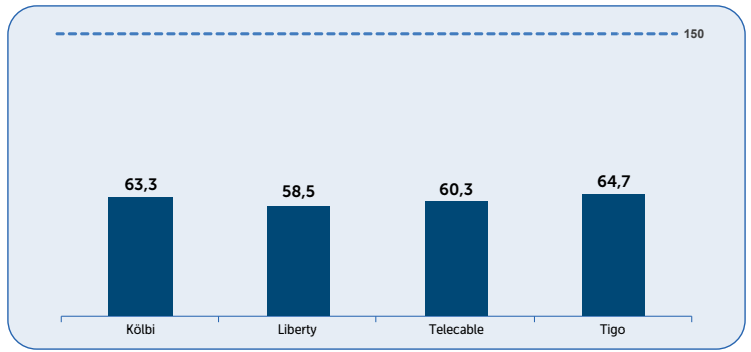
Below are the data compared with previous years.
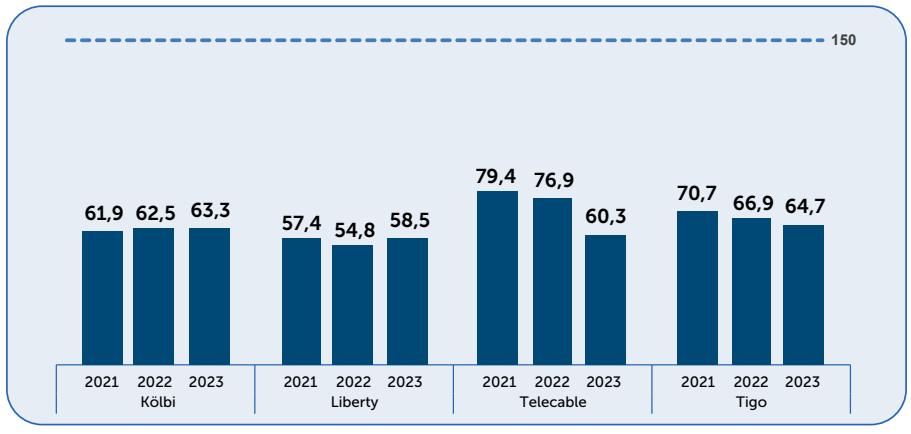
Did the Fixed Internet Services in Costa Rica Meet Quality Standards in 2023?
To accurately evaluate compliance with quality parameters for fixed Internet services in Costa Rica during 2023, a comprehensive analysis of national and provincial indicators for each operator was conducted. As in previous years, SUTEL used the MedUX system to continuously monitor and measure service performance, ensuring controlled conditions and the validity of the collected data.
The minimum quality thresholds established by the Service Provision and Quality Regulation (RPCS) are as follows:
- 80% compliance with the download speed contractually offered by operators.
- 80% compliance with the upload speed contractually offered by operators.
- 50 ms local latency to a destination within national territory.
- 150 ms international latency to a destination outside the country
In the following table, the complete data is presented, highlighting the total number of measurements carried out, the number that exceeded the quality threshold, and the proportion of measurements that met the established standards. If the indicator's result (i.e., the proportion of measurements that meet the threshold) is equal to or greater than the tolerance margin, then the indicator’s compliance is 100%; otherwise, compliance equals the indicator's result.
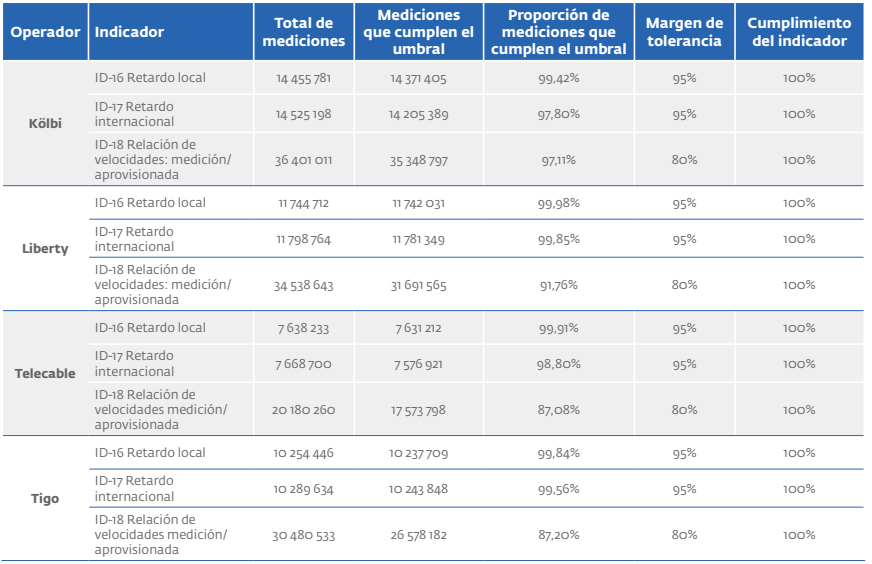
The 2023 results show a general improvement in the quality indicators for fixed Internet access services in Costa Rica. However, it is essential to examine the data at the provincial level to identify areas needing attention. A clear example is the case of Telecable, which has faced significant challenges in Alajuela province, as well as Kölbi.
The SUTEL Council requested an Improvement Plan from Telecable to address deficiencies in the Local Latency and Download Speed indicators. Despite implemented actions, the results reveal that although there has been an improvement in Local Latency, the Download Speed indicator still does not meet the required standards, especially between 7:00 PM and 10:00 PM. This has led to the application of a Quality Adjustment Factor (FAC) of 60.15%, resulting in a significant discount for users filing complaints. This case underscores the importance of operators focusing not only on national-level improvements but also addressing provincial deficiencies to ensure quality service for all Costa Ricans.
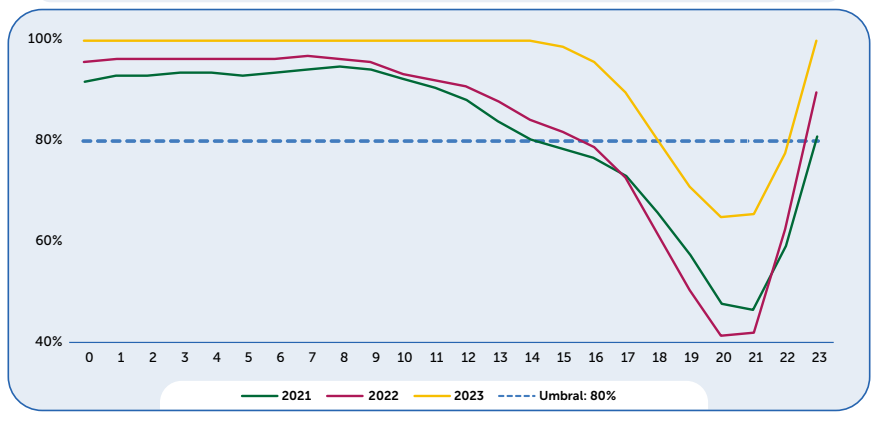
operador Telecable del 2021 al 2023 en la provincia de Alajuela (cifras en milisegundos). Source: SUTEL, Quality Department, Costa Rica, 2023
Another example is the case of Kölbi. The SUTEL Council requested an Improvement Plan through Agreement 006-036-2023, which Kölbi responded to with a document in July 2023. This plan aimed to resolve deficiencies in download speed in Limón province, specifically at 8:00 PM. The actions included expanding the transport network and international link capacity. The 2023 results demonstrate that the previously detected deficiencies are no longer present, with download speed performance in Limón during the critical hour reaching 90% and no records falling below regulatory thresholds in any metrics.
Therefore, although the overall outlook is positive, SUTEL recommends implementing additional Improvement Plans for operators failing to meet adequate levels in certain provinces. Should service quality deficiencies persist, tariff adjustments will continue to ensure users receive services aligned with established standards. This detailed approach will ensure operators commit to addressing observed shortcomings and, ultimately, provide quality Internet service to all Costa Ricans.
Tools for Evaluating Quality for End Users
To enhance transparency and give users more control over their telecommunications service quality, SUTEL has implemented various tools that allow Costa Ricans to learn about and evaluate the performance of these services in the country.
SUTEL Quality Map
This interactive platform enables users to consult coverage and quality of Internet and mobile network services across different regions of Costa Rica. With this tool, users can visually explore service performance in specific areas, providing clarity on available options.
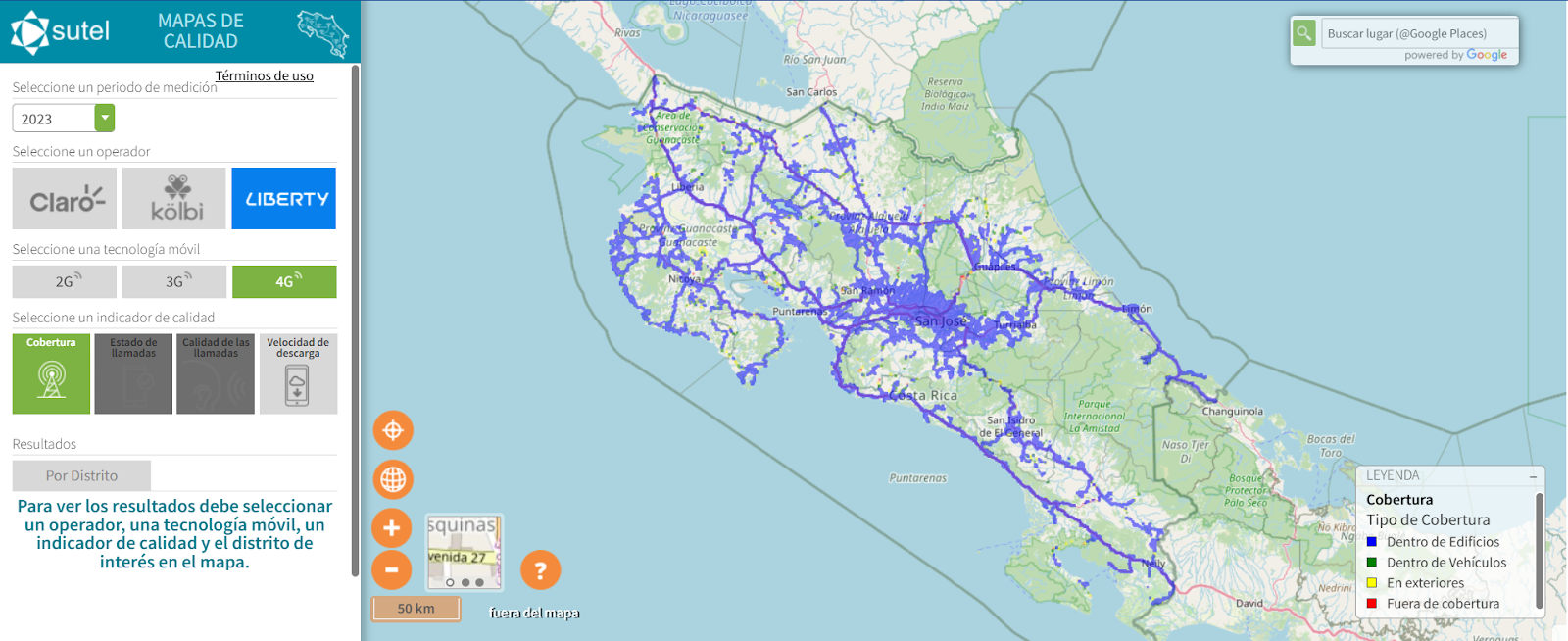
SUTEL Quality Viewer
The Quality Viewer is another tool that provides detailed data about fixed Internet services in different regions. It allows users to evaluate network performance in their localities and compare providers, helping them make informed decisions about their service.
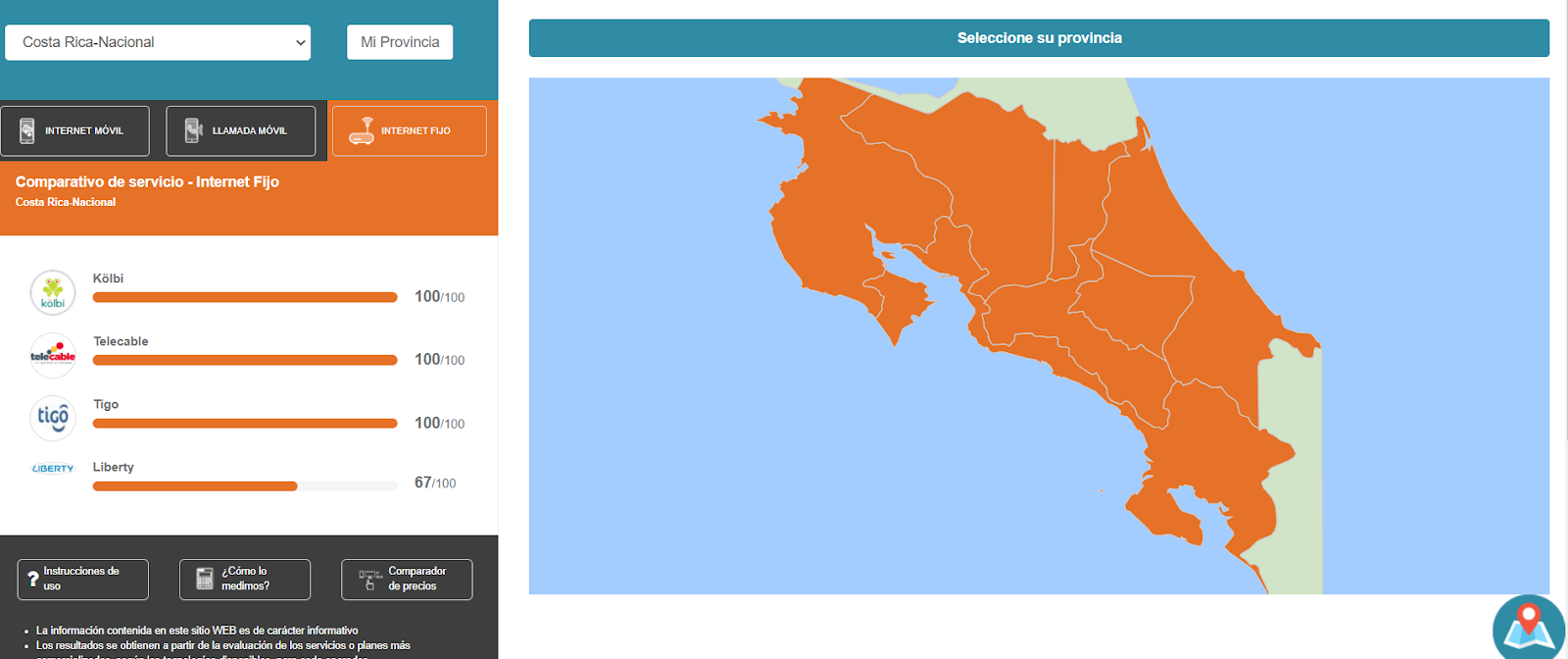
Reports on Fixed and Mobile Networks
SUTEL also makes periodic reports available to users on the quality of fixed and mobile Internet services in Costa Rica. These reports contain detailed analyses of network performance, keeping users informed about general and specific service quality nationwide.
With these tools, SUTEL seeks to ensure users have access to the information necessary to understand and improve the quality of their telecommunications experience in Costa Rica.
Conclusion
The evaluation of fixed Internet service quality in Costa Rica during 2023 reveals an overall favorable scenario, with significant progress compared to 2022. Operators have managed to meet most established parameters, particularly regarding local latency and upload speed at the national level. However, the provincial-level analysis has highlighted that, while some operators have improved, others still face challenges that need to be addressed.
Subscribe to our newsletter to receive our blog articles and much more!
Don’t forget to follow us on social media and subscribe to our newsletter to receive the latest updates and news.
Follow us on:
About MedUX
MedUX is the leading Quality of Experience (QoE) company, providing comprehensive and innovative solutions for measuring the performance of fixed, mobile, and TV telecommunications networks for telecom operators, governments, and digital enterprises. With a focus on delivering grand scale, end-to-end network, and service visibility, MedUX leverages real-time customer perspective data and advanced analytics to ensure quality and regulatory compliance, while also offering valuable insights for optimizing networks and improving customer experiences. With a presence in over 25 countries across Europe, America, Africa, and the Middle East, and monitoring over 60 operators worldwide, MedUX’s patented technology and expertise make it a trusted partner for improving the digital experiences of customers everywhere.
Explore the Latest from MedUX

Chile makes its network speeds visible: SUBTEL’s Regional Fixed Broadband Ranking (October 2025)
SUBTEL has released its October 2025 regional fixed-internet speed ranking, built from 767,924 measurements collected by probes from the Independent Technical Body (OTI). At MedUX, together with Microsystem, we’re the technical engine behind the OTI: we operate the measurement infrastructure and…

Chile Revolutionizes Internet QoS Measurement with a Multiplatform System
Ensuring Transparency and Reliable Connectivity with a QoS Measurement System in Chile In a digitized world, the quality of Internet service (QoS) is key to ensuring a stable and fast connection. Chile, recognized for its leadership in the telecommunications sector in Latin America, has taken a…

Quality of Mobile Networks in Costa Rica 2023: Coverage, Speed, and User Experience (II)
This article is part of a monographic series examining the state of telecommunications in Costa Rica. In this installment, we focus on mobile networks, essential for ensuring connectivity on the go and meeting the growing demands of users. We assess the quality, coverage, and performance of…


